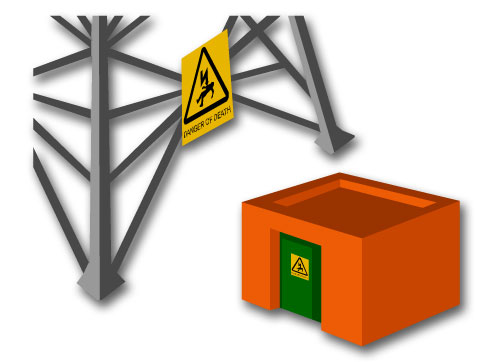In everyday language we often talk about 'transmitting electricity' from the power stationPower stations generate electric current in very large quantities for supply to the national grid. to where it's needed (for example, to a hospital or your home). However, in science we need to use more precise language, and we could say that 'transmitting electricity' is the way in which energy gets from the power station to your home. Electricity or electric currentElectric current is a flow of electric charges (electrons). is a method that we use to transfer energy from one place to another.
At the power station, the electric current is generated with a voltage of 25,000 volts. Shortly after the current leaves the power station, it is fed into a 'grid' substationSubstations are an important part of the national grid. They contain transformers which increase or decrease the voltage of an electric current. Substations are very dangerous if you try to tamper with them or vandalise them. Do not enter a substation for any reason - it is against the law and you could be electrocuted.. The substation contains a device called a transformerA transformer is a device that can change the voltage associated with an electric current. One type of transformer decreases the voltage and so is called a 'step-down' transformer. A 'step up' transformer increases the voltage. which increases (or 'steps up') the voltage to 400,000 volts ready for its journey to wherever it's needed.
High voltage
There is a good reason for using high voltages when transferring energy using electric current.
If a wire or overhead lineThick electric cables that carry electricity from where it is generated to where it is used. is carrying a large electric current, it heats up and energy is wasted by heating. If instead, the electricity is transmitted at a really high voltage, the current we need to transfer the same amount of energy can be much less and so less energy is wasted as heat.
Near to where the electricity is to be used, the voltage is reduced ('stepped down') in another substation. The electric current may pass through several substations on its journey to your home or to a factory, hospital or railway. Each substation reduces the voltage to whatever is required. Large factories and electric trains may require 33,000 volts, smaller factories may require 11,000 or 450 volts. We use 230 volts in our homes.
Find out more about substations.
Pylons, poles and buried power lines
Overhead lines are carried long distances across the countryside on tall metal pylonsA tall metal tower that carries very high voltage power lines. out of reach of people. Power lines may also be buried underground for extra safety - especially in or near towns and cities. In small towns and villages, power lines may be carried above ground on wooden poles.
Danger of death

You will see this danger of death sign fixed to pylons and substations everywhere you go in the UK. When you see this sign, you should take extra care.
Do you know how to be safe around electricity.



